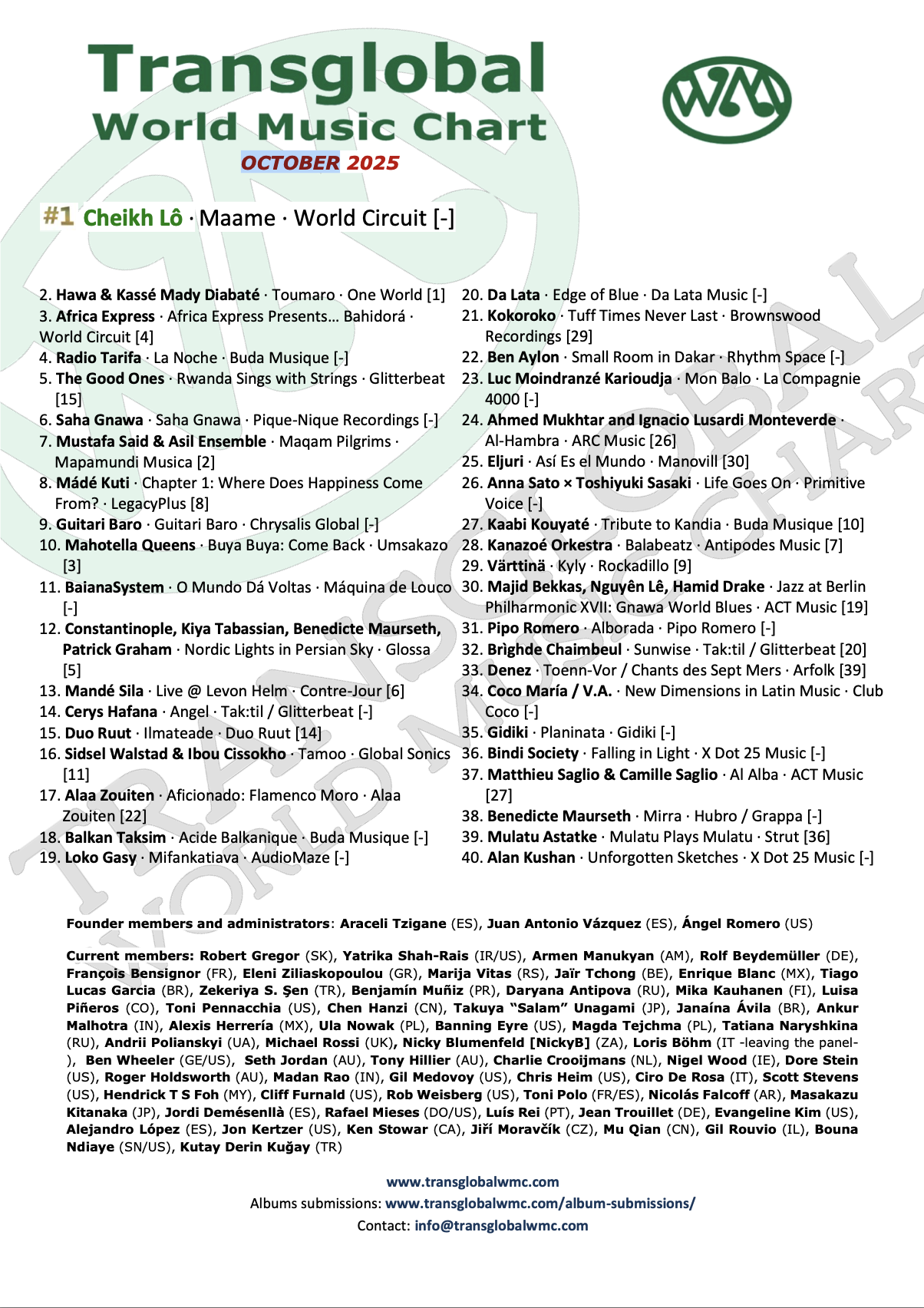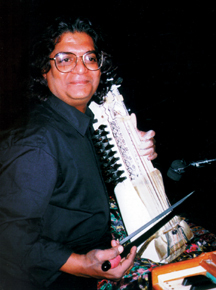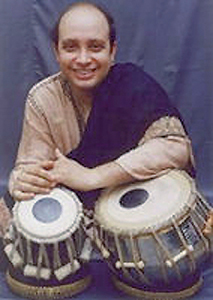Alan Kushan
Master of Santoor
East to East
by
Alan Kushan and Abhijit Banerjee
ALAN KUSHAN in Concert
The sufi lounge
New york
April 11, 2025
Just Released
unforgotten sketches
by
Alan kushan
Just released
Gate crashing
by
Alan kushan
Unforgotten Sketches hits No. 40
on Transglobal World Music Chart
Avant-garde musician and concert-performer; musical composer; musical instrument-maker; actor; singer; and poet.
Alan Kushan is arguably one of the most accomplished Santur players in the world. He stands out not only because of his brilliant realizations of traditional Persian compositions, but also for his innovative avant-garde soundscapes. He is not only a builder of Persian instruments but also a virtuoso in performing Persian traditional music. His style, however, is not limited to the traditional approaches but it extends itself beyond any such boundaries. He applies his own touch to the music that he performs, a touch which he has developed after experiencing the new trend of music, not only in his native land of Iran, but in the world, in this century.
Alan Kushan
Making Waves Music Festival - San Francisco
For over twenty five years, Alan has maintained an active involvement performing and composing for theatrical and cinematic productions. He is the recipient of numerous awards for his accomplishments including the 1991 Genie Award for "Best Short Film", and a nomination in 1993 for the Dora Mavor Moore Award for "Best Musical Score for Theatrical Production". Alan was recently honored as Associate Composer at the Canadian Music Center.
The instrument which he uses is also his own invention, which is designed after the traditional Persian Santur (hammered dulcimer), an old instrument with a sound box and several sets of strings. Each set usually consists of four strings which are tuned in the same pitch, so every four strings, which are supported by individual bridges, would sound the same in multiplied resonance when played with special wooden hammers. Similar instruments exist in different countries all around the world: Chinese Yan Chin, Indian Santur, and also the Rumanian Cimbalom. The structure ultimately is what the soundboard of a later invention, the piano, has been designed after.
Alan Kushan has passed through multifarious phases of musical composition and performance on his supremely delicate yet highly sophisticated musical instrument — his self-made hammered dulcimer or “NOU-Taan” also known as Santour. His compositions and arrangements range from traditional Eastern music to innovations with Western classical and Eastern mystical music, to jazz and world music and Avant-garde music, thereby creating newer, fresher, elevated musical forms. Alan Kushans performance method reveals an academically meticulous technique that is, paradoxically, in stark contrast to the "dream space" he generally endeavors to depict, and its markedly other-worldly, mystical dimensions.
The sound you hear in "Time Traveler Suite" in Pegah album is from a new and unique instrument designed and hand crafted by Alan Kushan, using strings from Piano, Harp and Harpsichord. This instrument creates a bass sound not found in the family of Santur, yet Alan has created this instrument using the Santur trapezoidal box concept, and plays it using Santur hammers.
Alan Kushan
Rumi Recording Sessions
One of Alan Kushan's many contributions to the SANTUR has been to broaden its musical range by increasing the number of bridges (notes) available to the musician. This expands the SANTUR from a typically restricted pitch area into an instrument capable of traveling previously unexplored musical territories. Alan designs and constructs these unique SANTURS and, in addition to differing gauges of steel and copper wire, he uses piano and harp strings to create fascinating variations in tonal quality.
Album Details:
Pegah (Dawn - A Persian Diaspora) (Persian Art Music)
Style/Genre: World Fusion
Instrumentation: Solo Santur
Pegah (Dawn) A Persian Diaspora - The dispersion of originally homogeneous people beyond the borders of time and place. A migration.
Alan Kushan is arguably one of the most accomplished Santur players in the world. The instrument which Alan uses is also his own invention, which is designed after the traditional Persian Santur (hammered dulcimer) The structure ultimately is what the soundboard of a later invention, the piano, has been designed after.
His creates brilliant realizations of traditional Persian compositions, combined with innovative Avant-guard soundscapes. The sound you hear in "Time Traveler Suite" is from a new and unique instrument designed and hand crafted by Alan Kushan, using strings from Piano, Harp and Harpsichord.
Tracks:
1. Pegâh-É Farvardîn (19:52)
2. Shûr (2:39)
3. Pâryâb (9:01)
4. ASA Banî (16:21)
5. Parvardégân (7:25)
6. Time Traveler Suite - Mosafer I (5:43)
7. Time Traveler Suite - Mosafer II (7:58)
8. Time Traveler Suite - Mosafer III (4:38)
Total time: 73:50
Item # CD 1006-2
Recorded at Mitch Park Recording Studio Engineer: Mitch Park
Mastered at Digisonic Studios by X DOT 25 & Victor Owens
Producer: Aldoush Alpanian - except * by X DOT 25
Executive Producers: X DOT 25 Music
Photo credits: Eli Goldman Liner
Notes: Jeff Obee
Package design and computer support: Koorosh Angali
1. Pegâh-e Farvardîn (the dawn of Farvardîn) (19:52) - Farvardîn is the first month of the Persian year. It also is the nineteenth day of each month in the ancient Persian calender. This is the day that the immaculate spirits of the ancestors descend from heavens to visit the earth thus the occasion calls for celebration. In the Avesta, the holy book of the Zoroastrians, this word is usually accompanied by the word ashawan, 'the righteous one(s).
2. Shûr (2:39) - One of the ancient dast-gâhs (musical patterns) which is still used. It is generally consisted of a minor root, a minor third and a minor fifth, however it is more complicated than these brief explanations. It should be heard to be realized and appreciated.
3. Pâryâb (9:01) - Generally it means agriculture while using the water which is provided by nearby rivers or artesian.
4. Asa Banî (16:21) - Literally Lady of the Horse(s) [asa, 'horse' compare with Engl. ass, 'donkey.' Banî and banû, 'lady' compare with New Persian, banû, 'lady'], wife of Pûrû Dakhshtî and one of the women whose frawashi, 'spirituality and holiness (in general)' has been praised and celebrated.
5. Parvardégân (7:25) - Parvardégân (also Farvardégân) are the last five days of Âbân, the eight month on the Persian calendar, which was held holy and was celebrated.
6. Time Traveler Suite* (Mosâfer Zamân) (18:20)
Mosâfer I (5:43)
Mosâfer II (7:58)
Mosâfer III (4:38)
Album Details:
Arctic Soul (Persian Art Music)
Style/Genre: New Age /World /Ambient
Instrumentation: Santur, Voices, Keyboards, Tabla, Sarangi.
Pandit Ramesh Misra - Sarangi
Ustad Pranesh Khan - Tabla
Those parts of thee that the world's eye doth view
Want nothing that the thought of hearts can mend;
All tongues, the voice of souls, give thee that due,
Utt'ring bare ruth, even so as foes commend.
--------- Shakespeare
The original compositions in this album reflect influences from Africa, Persia, India, Romania, and the Blues. The goal was to interconnect musical colors relating to a tranquil mind environment & Santur as an instrument. In this album Alan Kushan on Santur and Voices is accompanied by Pandit Ramesh Misra on Sarangi, Ustad Pranesh Khan on Tabla, Robert Simms on Keyboard & Percussion.
Tracks:
1 Indigo Void (5:27)
2 The Blues Voyager (5:52)
3 Avatar - the Dusty Poet (8:59)
4 Starless Planet Dance Goddess (9:18)
5 Khesed (8:02)
6 One of One (8:02)
7 Mehr O Mah (4:22)
Total time: 50:05
Item # CD 1014-2
Produced by Alan Kushan
Alan Kushan: Santur & Voices (All Tracks)
Pandit Ramesh Misra: Sarangi (Track 3)
Ustad Pranesh Khan: Tabla (Track 2, 3, 4, 6)
Robert Simms: Keyboard & Percussion (All Tracks)
Sound Design and Engineered By Steven Sena at SX Sound Studio.
Mastered by Albert Benichou at CD Premastering in Emeryville, California.
Mehr o Mah is Persian; Mehr means 'love & sun", Mah means "the moon".
Khesed in Hebrew means "loving & kindness". John Villa - Didgeridoo/percussion (Track 1)
Debo Priyo Sarkar - Tabla (Track 4) Cover Design: Farzaneh Foroughi
Alan Kushan, born in the mountains of Kurdestan, is arguably one of the most accomplished santur players in the world. He stands out not only because of his brilliant realizations of traditional Persian compositions, but also for his innovative Avant-guard soundscapes. He is not only a builder of Persian instruments but also a virtuoso in performing Persian traditional music. His style, however, is not limited to traditional approaches but it extends itself beyond any such boundaries. He applies his own touch to the music that he performs, a touch which he has developed after experiencing the new trend of music, not only in his native land of Iran, but in the world.
Pandit Ramesh Misra, mastering over one of the most difficult unique string instruments 'Sarangi', acquired training from finest musicians of Benaras Gharana, Pandit Hanuman Prasad Mishra and late Pandit Gopal Mishra and the legendary maestro Pandit Ravi Shankar. A recipient of India's most prestigious Sangeet Natak Award. His Sarangi can be heard in many music productions, including his solo albums and Ravi Shankar's 'Inside the Kremlin' and the Grammy nominated album 'Legacy' produced by the legendary Ali Akbar Khan. He also appears on 'Journey on the Strings' with Ustad Habib Khan and Swapan Chaudhuri. Pandit Misra is also one of the recording artists in Aerosmith's recent album.
Ustad Pranesh Khan, began his music studies with his grandfather Baba Allauddin Khan and father Ali Akbar Khan. He has studied with tabla legends Kanai Data, Shankar Ghosh, Alla Rakha, Zakir Hussain and Swapan Chaudhuri. Pranesh Khan is a master tabla player whose musical career includes performances with many noted European, American, and Indian musicians, including the Philadelphia String Quartet, Paul Horn, John Handy, Alice Coltrane and the Shanti and Third Eye fusion bands, Ali Akbar Khan, Aashish Khan, Nikhil Banerjee, Laksmi Shankar and G.S. Sachdev.
The ancient musical instrument SANTUR, has a unique trapezoid shape, and is more commonly known in the western world as the "hammered dulcimer". The origins of the SANTUR lie in ancient Persia and the instrument has inherited a proud legacy that is thousands of years old. Because of Persia's contacts with Greece, Rome, India, China, SANTUR found its way to such diverse areas of the world such as Ireland, Switzerland, Poland, the Ukraine, Hungary, Korea, and Germany. Each of these nations has adapted the SANTUR to its own musical temperament and has christened it with its own unique name. One of Alan Kushan's many contributions to the SANTUR has been to broaden its musical range by increasing the number of bridges (notes) available to the musician. This expands the SANTUR from a typically restricted pitch area into an instrument capable of travelling previously unexplored musical territories. Alan designs and constructs these unique SANTURS and, in addition to differing gauges of steel and copper wire, he uses piano and harp strings to create fascinating variations in tonal quality.The original compositions in this album reflect influences from Africa, Persia, India, Rumania, and Blues. The goal was to interconnect musical colors relating to a tranquil mind environment that Alan Kushan has absorbed since childhood.
Album Details:
east to East (Persian Art Music)
Style/Genre: World Fusion
Instrumentation: Santur, Tabla.
Alan Kushan - Santur
Ustad Abhijit Banerjee - Tabla
One of Alan Kushan's many contributions to the SANTUR has been to broaden its musical range by increasing the number of bridges (notes) available to the musician. This expands the SANTUR from a typically restricted pitch area into an instrument capable of traveling previously unexplored musical territories. Alan designs and constructs these unique SANTURS and, in addition to differing gauges of steel and copper wire, he uses piano and harp strings to create fascinating variations in tonal quality. In this album he is accompanied by Ustad Abhijit Banerjee on Tabla.
Tracks:
1 East (3:55)
2 Persia (6:20)
3 Tibet (9:56)
4 Kashmir (5:13)
5 Jerusalem (9:23)
6 Nepal (0:54)
7 Punjab (4:19)
8 Himalia (6:43)
Total Time: 46:46
Item # CD 1015-2
Ustad Alan Kushan - Santur
Ustad Abhijit Banerjee - Tabla & Voices
Produced by Alan Kushan
Mastered by Aldoush Alpanian
Cover Design by Farzaneh Foroughi
Mastering Engineer Albert Benichou at CD Premastering in Emeryville, California
The ancient musical instrument SANTUR, has a unique trapezoid shape, and is more commonly known in the western world as the "hammer dulcimer". The origins of the SANTUR lie in ancient Persia and the instrument has inherited a proud legacy that is thousands of years old.
This aristocratic instrument was played at every important ceremony and on festival occasions, especially at the imperial courts. Due to the fact that the Persian plateau has always, through the passage of the history of civilizations, served as an indispensable "bridge" between cultures and peoples of the East and those of the West, this musical instrument, the SANTUR, inevitably came to be introduced to other civilizations. this was achieved not only via the ancient and legendary "Silk Road" which Marco Polo traveled 700 years ago, but also by virtue of earlier contact between the Achaemenean Persians (599 BC-333 BC) and the ancient Greeks. This exchange was continued by the Sassanian dynasty of Persia (224-637 AD) through her cultural and diplomatic links with the Roman Empire. Because of Persia's contacts with Greece, Rome, India, China, the SANTUR found its way to such diverse areas of the world such as Ireland, Switzerland, Poland, the Ukraine, Hungary, Korea, and Germany. Each of these nations has adapted the SANTUR to its own musical temperament and has christened it with its own unique name.
Abhijit Banerjee
One of Alan Kushan's many contributions to the SANTUR has been to broaden its musical range by increasing the number of bridges (notes) available to the musician. This expands the SANTUR from a typically restricted pitch area into an instrument capable of travelling previously unexplored musical territories. Alan designs and constructs these unique SANTURS and, in addition to differing gauges of steel and copper wire, he uses piano and harp strings to create fascinating variations in tonal quality.
Abhijit Banerjee
Abhijit Banerjee received his initial training in tabla from Tushar Kanti Bose and then from Manik Pal. Later on he became a disciple of the legendary tabla maestro, the late Pandit Gyan Prakash Ghosh. As a child he won many music competitions of national repute. Besides TABLA he had his training in Vocal Music and in Violin. He represents the Farukhabad gharana of tabla playing.
At present Abhijit is considered as one of the leading tabla players. He is recognized for his skillful accompaniment as well as for his solo performances. He has been on concert tours with most of the leading classical musicians of India both in North Indian and South Indian tradition. He has toured all over the world and also performed with jazz musicians and groups in New York. Abhijit teaches Indian Classical Music at Universities in U.S.A., Japan, England and Spain.
Alan Kushan, born in the mountains of Kurdestan, is arguably one of the most accomplished santur players in the world. He stands out not only because of his brilliant realizations of traditional Persian compositions, but also for his innovative avant-guard soundscapes. He is not only a builder of Persian instruments but also a virtuoso in performing Persian traditional music. His style, however, is not limited to traditional approaches but it extends itself beyond any such boundaries. He applies his own touch to the music that he performs, a touch which he has developed after experiencing the new trend of music, not only in his native land of Iran, but in the world.
Album Details:
uNFORGOTTEN sKETCHES
Style/Genre: World Fusion
Instrumentation: Santur, Tabla
Alan Kushan, avant-garde musician and concert-performer of Persian/Iranian descent; musical composer; musical instrument-maker; actor; singer; and poet. Alan is an internationally recognized Persian avant-garde 'santurist', and the leading exponent of the New Santur style. After passing through multifarious phases of musical composition and performance on his supremely delicate yet highly sophisticated musical instrument - his self-made hammer dulcimer or santur, ranging from traditional Persian music, to fusions of Western classical and Persian mystical music, to jazz and world music, as well as futuristic and avant-garde music, Alan Kushan is still audaciously and earnestly experimenting in the musical realm. His techniques on his self-made santur are indeed altogether fascinating and breathtaking. He studied music composition in Zurich, Köln and Berlin as well as Canada and USA; he also studied with Sir Yehudi Menuhin, Karlheinz Stockhausen and other master musicians.
Tracks:
1. Nima Yooshij (4:47)
2. Khayyam (7:16)
3. Hafez (7:34)
4. Molavi Rumi (6:23)
5. Saadi Shirazi (3:31)
6. Ferdowsi (8:30)
7. Sanai (6:41)
8. Sohrab Sepehri (5:36)
9. Akhavan-Sales (5:15)
Alan Kushan: Santur
Pepe Danza: South American and Chinese Flute
Andreas Karreh: Percussion
Kai Eckhardt: Bass
Recorded and Mixed at:
Steven Sens Studio: Berkeley, California
Studio: CBC Toronto, Canada
Studio: Richard Horowitz, NYC
Review:
Alan Kushan is about tuning, very subtle tuning! Everything about him is in tune. -- Richard Horowitz: Composer, Performer and Producer.
By: Richard Horowitz:
The following was written while listening to the album, not before, not after.
1. A dense nucleus of thought forms shape, shift in waves of melismas.
2. The Santur is a spider web trapping an exotic bird made of microtonal wind: the tables devour the winds.
3. The Santur is a billion-year-long humming bird feasting on the carcass of a black hole: the beat shifts and a ritual footless waltz turns on an axis of split-seconds.
4. Darkness, dissonance, expectation: one of Kushans most tight-roped moments! Echoes of Zarathustra. The introduction leads down the path to a cave where dreams are stored. There is a throne made of vibrating unstruck strings; on it sits Kushans perfectly disembodied voice luring us to a circular hole at the top of the cave. We rise and converge with him into the night sky.
5. Warmth, confidence, courage! Mahour Alan is flying over his most precious memories.
6. The Karatesque deftness of Kushan’s ultra-light mallets generate a relentless macrospiral that collides with the percussion as if it were the beginning of a cosmic battle with gravity itself, which in Kushan’s ultra-fluid world is either the same as or the origin of memory (since gravity is now thought to act interdimensionally on the dissonance in the overtone structure to create matter, as it were, according to Jaron).
7. Raga Todhi. Kushan attacks shadows of overtones with mallets made of fire and tears. His voice glides over the buzzing of souls guiding them to the inner secret he has come to reveal.
8. An old wooden boat arrives on a beach at night. A majestic fire dance and sacrifices are being performed.
9. The dancers leave the beach and start running through a wide valley. Their eyes are stars shooting solar flares through the mountains. Faster and faster they run, unable to stop. There is no end.
Album Details:
Gate Crashing
Style/Genre: World Fusion
Instrumentation: Santur, Tabla
New Genre Electronic Acoustic Music Gate Crashing: A Dimension to Unlocked Memories. This musical album is a journey where there is no substance of Time, Space, or Forms. You are part of these mysterious phenomena. It begins and fades out; it travels within everything such as countless Galaxies, which also are traveling in other universes and Alan believes that our locked memories are an immense part of these universal Structures.
He does not particularly remember that he belongs to any precise part of this vast creation and it would be extremely difficult for him to explain its incomprehensible immensity. Question such as what is thinking? Where is it coming from? Or what is the highest level of it? So mystical and transparent it is and yet, unexplainable to infinity. Those that claim that they have found the answer are still wondering and many others are still fantasizing. Dreaming of the ultimate emancipation without being forced into oblivion territories. Do you think to quest for the ultimate emancipation is locked in our memories? Q…: What is hope/ Perhaps it is the only source that enlighten us and teaches us more of unknowns.
Tracks:
1. UMMA (5:24)
2. NTPPUL (8:11)
3. UR (3:06)
4. THURGAU (4:17)
5. HELVETIC (4:07)
6. AKAD (5:31)
7. SHUSHA (7:10
8. ERTDU (1:53)
9. SAIGHIR (9:28)
10. PLOVDIV (4:03)
Alan Kushan: Santur
Alan Kushan: Compositions, Voices, Percussion Programming, Sequencing
Noha Waldman: Drums
Roy Watanabe: Guitar
Sample of Master violinist A. Malek (by Permission).
This Project was done in 3 different recording studios:
1- Steven Sena Berkeley
2- Safran. Noha Waldman's in San Francisco
3- Richard Horowitz, NYC




























































